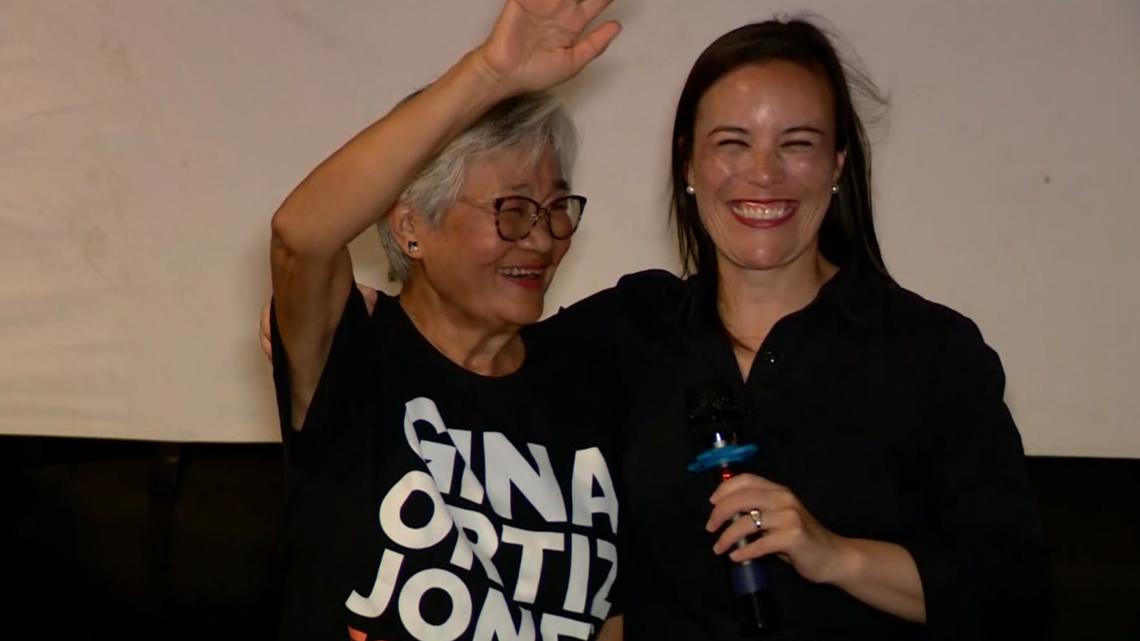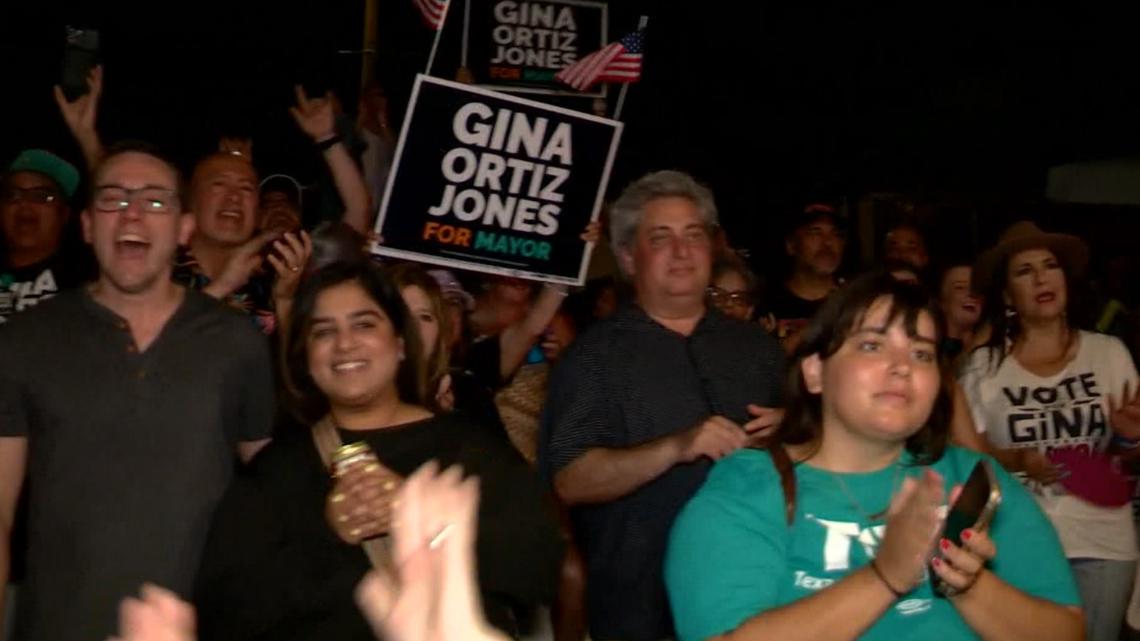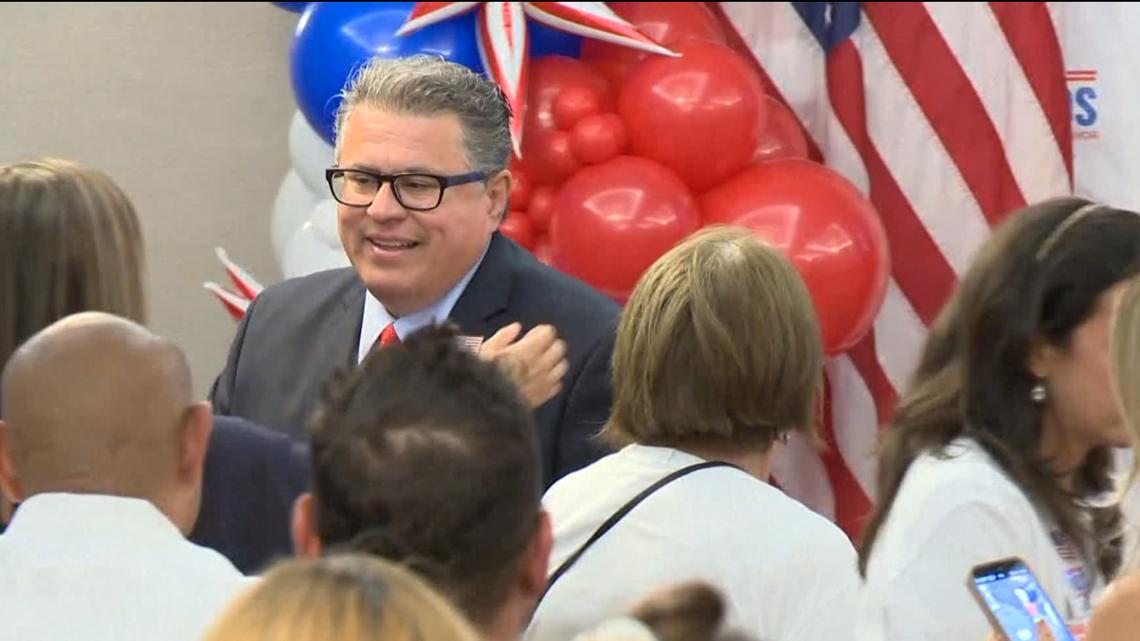Jones bested her runoff competitor, Rolando Pablos, in a runoff election and will lead the Alamo City for the next four years.
SAN ANTONIO — Gina Ortiz Jones declared victory and her opponent, Rolando Pablos, congratulated her on the win as a prolonged San Antonio mayoral race reached the finish line on Saturday night.
Shortly after, San Antonio’s remaining vote centers reported their results, padding her historic victory. She finished with 54.3% to her opponent’s 45.7%, and will be sworn in as Mayor Ron Nirenberg’s successor on June 18.
Jones in the process will become the city’s first out LGBTQ+ mayor and the first to win the office without City Council experience since Phil Hardberger in 2005. More than 12,000 votes separated her from Pablos in the final tally.
Nirenberg will leave office after serving eight years, the most allowed under the City Charter. But Jones will be the first Alamo City mayor to serve a four-year term, following voter-approved changes to the charter last fall. She’ll be eligible for reelection in 2029.
“As we move forward as a community, I am very thankful for the opportunity to serve with everybody in mind,” Jones said at her watch party, to applause from supporters. “We reminded folks what San Antonio stands for. We reminded them that our city leads with compassion.”
Jones, a west-side native and daughter to a single mother who immigrated to the U.S., is celebrating her first election to public office, having run for Congress twice in recent years. She took time to thank supporters on Saturday night, and shouted out LGBTQ groups and volunteers as her victory became increasingly assured.




At multiple points in her campaign, Jones positioned herself as someone who would safeguard San Antonio interests against federal and state policies that she believed could be detrimental.
The Air Force veteran underscored that stance again on Saturday night, welcoming to the stage a transgender Air Force drill instructor who she said was “getting kicked out” as a result of President Donald Trump’s recent executive order banning trans military personnel from serving.
“As we think about what’s going on in this moment in time, there’s a lot going on at the federal level, a lot going on at the state level,” she said. “But we here in San Antonio – deep in the heart of Texas – reminded folks what San Antonio stands for. We reminded them that our city is about compassion, about leading with everybody in mind.”
The Democratic National Committee said in a statement that Jones’ win overcame “massive amounts of right-wing dark money,” adding she will “move San Antonio forward.”
Pablos, speaking from his watch party at Drury Inn, acknowledged the contest was “very tough.” The former Texas secretary of state finished second to Jones in the jam-packed May election, and found himself in the same position a month later—coming up 12,000 votes short of leading a city where he wanted to fight poverty and rejuvenate economic opportunity from the mayoral office.
“San Antonio continues to be a blue city,” he said. “(The race) became highly partisan, and today it showed. Hopefully we can work together. We did this for the betterment of the community.”


Jones staked an early lead Saturday night when the early votes came in shortly after 7 p.m.; she won about 52.3% of those ballots. Pablos, in order to overtake his opponent, would have needed an Election Day boost that never came.
Instead, Jones’ lead steadily grew and grew until there were no more vote centers reporting results. Turnout came in at 16.99%, a low figure that still bested May’s turnout. Of the more than 840,000 registered San Antonio voters, 142,686 voted in the mayoral runoff election.
The mayoral contest’s final result nearly mirrored Nirenberg’s first win in 2017, when he collected 54.6% of the vote.
The relatively close race in historically blue San Antonio reflected just how intensely partisan the technically non-partisan race has become since the May 3 election in which they beat out 25 other candidates, including four sitting City Council members.
One expert, Jon Taylor, a UTSA political science professor, said he anticipated the race to be “relatively close” between the two candidates.
“Whoever wins, it’s gonna be a historical election,” Taylor told KENS 5 leading up to Election Day. “The narrative will be much different: San Antonio elects a progressive woman as mayor versus a conservative Republican who’s elected who might be emblematic of a new trend of blue cities electing more conservative mayors.”
Jones will be joined by four new City Council members when she’s sworn in later this month.
About the mayoral contest
Pablos entered the race in August and Jones joined a couple months later in December. They ended up being the top two vote-getters in the jam-packed May 3 election.
With the pair headlining June’s runoff, the race had taken on a partisan scope.
Jones, a former U.S. Air Force under secretary who served under then-President Joe Biden, has blasted Gov. Greg Abbott’s school voucher initiative and criticized local ICE operations in rounding up undocumented migrants. She had won the endorsements of more progressive members of City Council, including Jalen McKee-Rodriguez and Phyllis Viagran.
Jones has cited expanding free Pre-K services and protecting public education among her priorities, and has expressed concerns about transparency regarding Project Marvel, the city’s multibillion-dollar plan to revitalize downtown.
Pablos served as Texas secretary of state for two years under Abbott and has been staunch in his support for law enforcement and smart budgeting. He secured endorsements from Marc Whyte, the most conservative member of the current City Council makeup, as well as San Antonio’s police union. His campaign’s focus points: tackling poverty, infrastructure and smart spending.
Jones will be expected to get up to speed quickly before diving into annual budget discussions. In the long term, she will help carve the city’s future as it relates to growth, Project Marvel, 2027 bond priorities, and issues like poverty and lack of affordable housing.
“Our city is stronger when we’re thinking also about the most vulnerable in our community, and (when) we’re making smart investments,” she said Saturday night. “So we’ve got a great opportunity, a number of opportunities, (while) focusing on everybody.”
